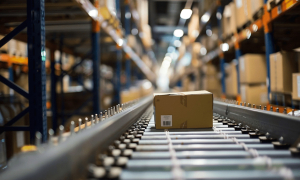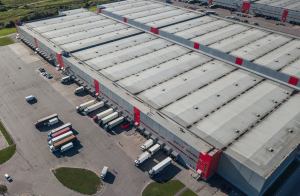In the world of supply chain logistics, the pace of change keeps accelerating. As we move into 2026, this tech revolution shows no signs of slowing down, and businesses that fail to adapt risk falling behind. From artificial intelligence (AI) and the Internet of Things (IoT) to blockchain and robotics, these innovations are reshaping the way goods move from point A to point B—creating new opportunities for efficiency, transparency, and cost savings. Let’s explore how these emerging technologies are transforming supply chain logistics and how Stream Logistics can help you harness their full potential.
The Role of Technology in the Supply Chain Logistics Revolution

The traditional supply chain model focused on moving goods from suppliers to consumers as quickly and cost‑effectively as possible. That linear approach is being replaced by a more complex, dynamic, and data‑driven system that leverages cutting‑edge technologies. In 2026, companies aren’t just chasing faster delivery—they’re aiming for more agility, resilience, and transparency across supply chain logistics operations.
Artificial Intelligence and Machine Learning
AI and machine learning sit at the heart of this tech revolution. These tools enable logistics companies to predict demand more accurately, optimise delivery routes, and automate repetitive tasks. For example, AI can analyse historical data to forecast demand spikes or identify potential disruptions before they happen. This foresight improves inventory management, reduces stockouts, and keeps operations flowing.
Machine learning can also optimise transportation routes in real time, considering weather, traffic, and road closures. The result is fewer delays, lower transportation costs, and better customer satisfaction—key gains for modern supply chain logistics.
Internet of Things (IoT)
The Internet of Things (IoT) covers physical devices—sensors, GPS trackers, and RFID tags—that share data in real time. In supply chain logistics, IoT is transforming asset tracking and visibility by monitoring the location and condition of goods throughout the journey.
With IoT‑enabled devices, companies can track shipments in real time to provide accurate delivery estimates and prevent loss or damage. For a deeper dive on visibility, explore real‑time freight tracking and smarter logistics real‑time freight tracking and smarter logistics, and see how proactive monitoring improves customer service and reduces costly exceptions.
Blockchain Technology
Blockchain is a decentralised, tamper‑resistant ledger that records transactions. In the supply chain, it tracks the movement of goods from manufacturer to end consumer, creating an immutable record along the way.
By leveraging blockchain, businesses increase transparency and traceability so all parties work from the same information in real time. This reduces fraud, improves compliance, and helps prevent counterfeiting—especially in pharmaceuticals, food, and luxury goods. Smart contracts can also reduce paperwork, speed transactions, and cut errors.
Robotics and Automation
Robotics and automation are reshaping warehousing and distribution. Automated guided vehicles (AGVs), drones, and robotic arms move goods, manage inventory, and perform quality checks in distribution centres. They work around the clock to lift efficiency, reduce labour costs, and minimise human error.
Drones are increasingly used for last‑mile deliveries in select regions, while AGVs autonomously transport goods within warehouses, optimising space and speeding pick‑and‑pack. When cargo is oversized, time‑critical, or complex, project logistics expertise project logistics expertise helps ensure safe handling from planning to delivery.
5G Connectivity
The rollout of 5G is another game‑changer for supply chain logistics. With ultra‑low latency and high data throughput, 5G enables real‑time communication between devices, vehicles, and systems. This connectivity boosts the effectiveness of IoT, AI, and robotics—creating a more responsive, integrated network.
For instance, 5G helps autonomous vehicles communicate with traffic systems to improve safety and traffic flow. It also strengthens shipment tracking for more accurate delivery updates and fewer delays.
The Challenges of Integrating New Technologies in Supply Chain Logistics

Despite clear benefits, integrating new tools into existing operations is hard. Barriers include implementation costs, skills gaps, change resistance, and interoperability across multiple stakeholders. Overcoming these hurdles requires a partner who understands both technology and supply chain logistics execution. That’s where Stream Logistics comes in.
How Stream Logistics Can Help You Embrace the Future of Supply Chain Logistics
Stream Logistics provides logistics and supply chain solutions that help businesses harness emerging technologies without disrupting day‑to‑day operations. Our team tracks the latest trends and applies them pragmatically so you can modernise at the right pace and in the right places.
Whether you’re scaling domestically or moving goods across borders, our team coordinates permits, timelines, and hand‑offs. For international moves that require customs control and deferred duty options, learn about international shipping with sufferance bonded warehousing international shipping with sufferance bonded warehousing to keep freight flowing.
The supply chain logistics landscape is changing fast. From AI and IoT to blockchain, robotics, and 5G, the technologies above are reshaping how goods are produced, tracked, and delivered. We can help guide your business through this evolution—positioning you for success in 2026 and beyond.
Contact Stream Logistics to explore a roadmap that fits your operation and risk profile.









